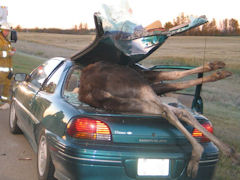by James A. Bacon
In the course of researching another article, I’ve come across some fascinating data from an American Automobile Association report from two months ago, “Crashes Vs. Congestion: What’s the Cost to Society?”
While public policy seems to focus mainly on the cost of congestion, the AAA contends that the cost of vehicle accidents is three times higher than that of congestion — roughly $300 billion a year vs. $98 billion in 2009. While congestion costs millions of Americans lost time valued at several hundred dollars each a year, accidents, though fewer in number, are astronomically higher in cost — $6 million for a fatality, $126,000 for an injury, plus property damage. When you consider that there are 30,000 fatalities and 2 million injuries a year, those numbers add up really quickly.

AAA provides a breakdown for Virginia’s three major metropolitan areas. It is interesting to see that the Richmond metro region has more fatalities than Hampton Roads, a region half again as large, and a rate considerably higher than metropolitan Washington, a region five times its size. While per-capita congestion costs increase with the size of metropolitan areas, the per-capita crash costs decline, the study finds.
The report contains an interesting discussion to explain the phenomenon:
A complex relationship exists between congestion and crashes. Although the evidence is mixed, less congested roadways appear to lead to fewer, but more severe, crashes. This relationship is especially strong in the case of crash severity; that is, more severe crashes occur on less congested roadways due in large part to faster speeds. On more congested roadways, the number of crashes may increase, but they may be primarily minor crashes reflecting the increased weaving and access/egress movements often occurring on congested road segments. Crashes may also lead to severe, unexpected congestion in an otherwise congestion-free roadway, reducing the level of service.
The study is an eye-opener for me. I have paid little attention to traffic safety issues, thinking them a second-order issue. Clearly, that’s not the case, as it shouldn’t be for anyone who values human life. I can plead only that the public policy debate has revolved mainly around easing congestion. I would speculate that’s because road builders and developers exercise a lot more clout in the General Assembly than AAA and Mothers Against Drunk Driving. If AAA’s numbers are close to accurate, a greater focus on safety would offer a much higher societal Return on Investment than a focus on congestion mitigation or even economic development. Perhaps our highest priorities should be micro investments like guard rails, wider shoulders, reflective lights, better law enforcement and the like, not laying more asphalt.
The high cost of automobile accidents also bears upon the question of which modes of transportation are preferable. Mass transit, I would speculate, has a much lower per-capita rate of accidents and economic loss due to accidents. I’m not sure that differential is properly factored into our modal funding priorities.



